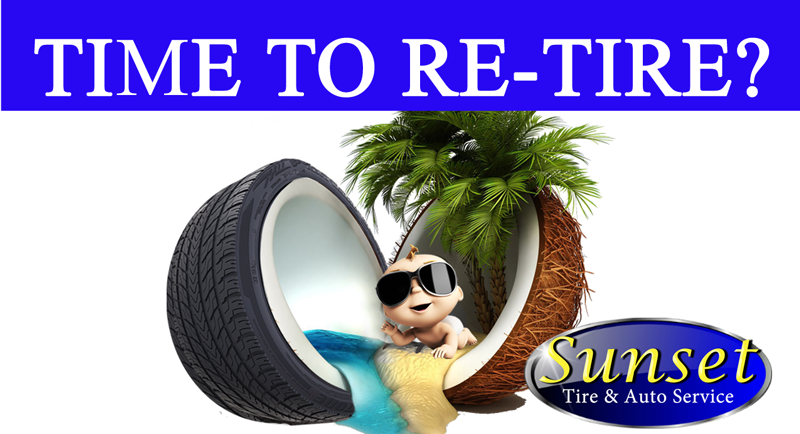
Come to Sunset Tire And Auto Repair with all of your Tire Needs!
TIRE INSTALLATION
Your vehicle's tires make constant contact with the road. Over time and with normal wear-and-tear, your become worn down. This can be dangerous when braking on wet or snow-covered roads. Hydroplaning occurs when the tire's grooves are so worn down that they don't channel water out from beneath the tread. When this happens, your treads only skim the water's surface and the steering wheel won't respond. Keep your tires in working condition.
How do I know if I need new tires?
- Your tread depth is below 1/16 of an inch (1.6 millimeters). To get a rough idea of your tread depth, use a penny and insert it "head down" into the tread. If you can see Lincoln's entire head, you need new tires.
- Your tread wear indicator bar is visible. Flat rubber bars run perpendicular to the tread. If you see them, it's time for new tires.
- Your tire's sidewall is showing visible cracks or cuts. Take this seriously; your tires may soon start to leak.
- Your tires have developed bulges or blisters. Weak spots on tires show up around blisters or bulges and can blow out your tires.
If you see any of these signs, you need to have them checked and replaced. We carry a number of brand name tires to choose from, and our trained technicians will install them properly.
TIRE REPAIR/FLAT REPAIR
An improperly repaired tire may fail when driven at high speed causing loss of vehicle control.
Flat or damaged tires need to be repaired by qualified personnel.
Almost any sharp object on the road can cause a flat tire. We repair tire tread punctures up to 1/4" in diameter. We do NOT recommend repairing larger punctures or punctures to the tire's shoulder and sidewall.
Do not attempt to repair the tire while it is still connected to the wheel.
You must inspect the inside of the tire for hidden damage or risk weakening the tire. Punctures in the tread area may damage a greater area of the tire like the inner sidewall. Without removing the tire, it's hard to see all the damage.
Proper tire repair is critical and any puncture or injury to a tire will affect its performance. If you have any questions regarding your tire's condition, we'll be glad to inspect them for you.
Call or email us to repair or replace your damaged, punctured or leaky tires.
TIRE ROTATION
The front tires on a front-wheel drive vehicle accelerate, steer, and help brake your vehicle. Front tires tend to wear down faster than rear tires. Typically rear wheel tires last twice as long as front wheel tires. Ideally, we recommend you replace all four tires at the same time. Rotating your tires helps ensure even wearing for all your tires. Contact our staff to get your tires rotated.
How do I know when to rotate my tires?
Follow your vehicle's owner's manual suggestions, rotate them with every other oil change, or rotate them every 3,000 to 7,000 miles.
TPMS SERVICE
A TPMS or "Tire Pressure Monitoring System" electronically monitors the air pressure inside your tires. Depending on your vehicle, the TPMS reports the tire-pressure information, through a gauge, a pictogram display, or a low-pressure warning light. This system can be divided into two different types—direct (dTPMS) and indirect (iTPMS). As of September 1, 2007, the TREAD (Transportation Recall Enhanced Accountability and Documentation) Act requires that all vehicles sold in the U.S. be equipped with one of these types.
Direct TPMS reports tire pressure in real-time through pressure sensors installed directly in the valve of each tire.
Indirect TPMS uses the car's anti-lock braking systems (ABS) to approximate tire pressure. Since tire inflation levels affect tire rotation, indirect TPMS also relies on the differences in wheel rotation to detect under-inflation.
Benefits of TPMS:
- Avoid traffic accidents: Recognize under-inflated tires before they malfunction and create an accident.
- Extend tire life: Under inflation contributes to heat buildup, tire disintegration, ply separation and sidewall/casing breakdowns.
- Improve safety: Properly inflated tires add stability, greater handling, and braking efficiencies while providing better safety for the driver, the vehicle, and others on the road.
Having trouble with your TPMS? Give us a call today and our professional team will take care of it for you.
Warranties



